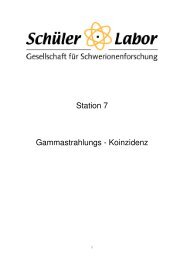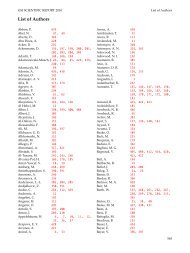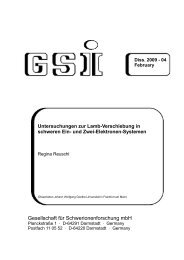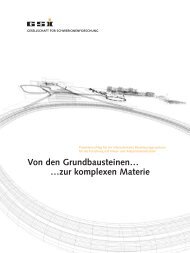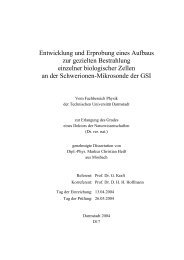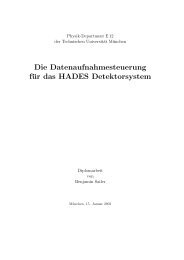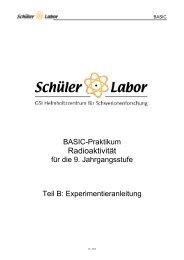CBM Progress Report 2006 - GSI
CBM Progress Report 2006 - GSI
CBM Progress Report 2006 - GSI
You also want an ePaper? Increase the reach of your titles
YUMPU automatically turns print PDFs into web optimized ePapers that Google loves.
<strong>CBM</strong> <strong>Progress</strong> <strong>Report</strong> <strong>2006</strong> Detector Developments<br />
<strong>CBM</strong> calorimeter consisting of 12 × 12 cm 2 cells. Reconstruction<br />
quality degrades for larger cells, varying from<br />
71% for 8 × 8 cm 2 cells to 49% 12 × 12 cm 2 cells.<br />
Direct photons and their correlations<br />
Measurement of photons (and reconstruction of π 0 and<br />
η mesons) with ECAL is important for realization of the<br />
<strong>CBM</strong> research program. Direct photons (i.e. not originating<br />
from decays) can be subdivided in prompt ones<br />
from initial hard processes with large pt, photons from<br />
initial quark-gluon stage and from later hadronic interactions.<br />
Existing transport generators do not include direct<br />
photons [1]. Cross section for the main hadronic source<br />
(reactions πρ → πγ and ππ → ργ) has been prepared by<br />
the ECAL group and implemented into the HSD transport<br />
code. Our estimations [1] have shown that with expected<br />
hight-intensity ion beams (10 9 /s) the rate of prompt photons<br />
with pt > 2GeV/c would be ∼ 100/s for central<br />
Au − Au collisions at 25AGeV .<br />
The momentum correlations of photons provide unique<br />
information on the reaction mechanism which is hardly accessible<br />
by all other means. The correlation strength parameter<br />
helps to determine the direct photon yield. The<br />
two-photon correlation function shown in Fig.3 was calculated<br />
with the source size parameter r0 = 5 fm and different<br />
direct photon yields d = N(γD)/N(π 0 ). The direct<br />
photons were generated according to the thermal-like momentum<br />
distribution dN/dp ∼ (p 2 /E) exp (−E/T0) and<br />
mixed with 10 5 UrQMD events (Au + Au at 25AGeV ).<br />
The two photon correlation function is a combination of the<br />
direct photon correlations (R = 1 + λ exp (−Q 2 inv r2 0)) and<br />
residual correlations between photons from π 0 decays. For<br />
large values of direct photon fraction d one could observe a<br />
clear peak at small Qinv. The height of this peak depends<br />
quadratically on parameter d. The height of the correlation<br />
function in (¯h/r0 − mπ0 ) region of Qinv depends on parameter<br />
d linearly and could be considered as an additional<br />
source of information on direct photon fraction.<br />
Figure 3: Two photon correlation function<br />
Prototype of Preshower detector<br />
Following the experience of ALICE TOF group [2] we<br />
have built and tested the prototype of <strong>CBM</strong> preshower<br />
detector based on scintillator-fiber system. Light registration<br />
was performed with Avalanche Photo-Diodes with<br />
Metal-Resistance-Semiconductor structure (MRS APDs)<br />
operated in the Geiger mode. These detectors were invented,<br />
designed and are currently produced in Moscow at<br />
Center of Perspective Technologies and Apparatus (CPTA)<br />
[3]. With moderate bias voltage of 50-60 V these detectors<br />
demonstrate intrinsic gain of up to 10 6 . MRS APDs<br />
do not require special housing or fragile light transporting<br />
system and can be mounted directly inside scintillating<br />
plates, simplifying the construction of large detectors.<br />
Size of scintillating plates was set equal to 104 × 104 × 5<br />
200<br />
180<br />
160<br />
140<br />
120<br />
100<br />
80<br />
60<br />
40<br />
20<br />
Pedestal<br />
Signal<br />
0<br />
0 100 200 300 400 500 600<br />
ADC counts<br />
Figure 4: Amplitude spectrum from Preshower prototype.<br />
mm 3 as dictated by ITEP beam test facility. Light collection<br />
inside plastic plate is performed by Kuraray Y11<br />
wavelength-shifting (WLS) optical fiber (1mm in diameter)<br />
which was packed in narrow circular groove engraved<br />
on the plastic surface. One end of fiber piece is covered<br />
with reflecting foil, while the other is pressed to the sensitive<br />
surface of MRS APD. MRS APD signal amplification<br />
and control of bias voltage was done with special front-end<br />
electronic card. A typical amplitude distribution from minimum<br />
ionizing particles obtained during prototype beam<br />
tests is presented in Fig.4. A clear gap separates the trigger<br />
events from pedestals (particles missed the detector). An<br />
average light yield measured with 60 detectors equals 9-12<br />
electrons/MIP. Increasing the thickness of scintillating tiles<br />
and filling fiber grooves with optical glue we would be able<br />
to increase the overall light output by factor 2.<br />
References<br />
[1] S.M. Kiselev, hep-ph/0701130<br />
[2] A.Akindinov, G.Bondarenko, V.Golovin, et al. Nucl. Instr.<br />
And Meth. A539 (2005) 172.<br />
[3] G.Bondarenko, V.Golovin, M.Tarasov, Patent for invention of<br />
Russia No. 2142175, 1999.<br />
47



